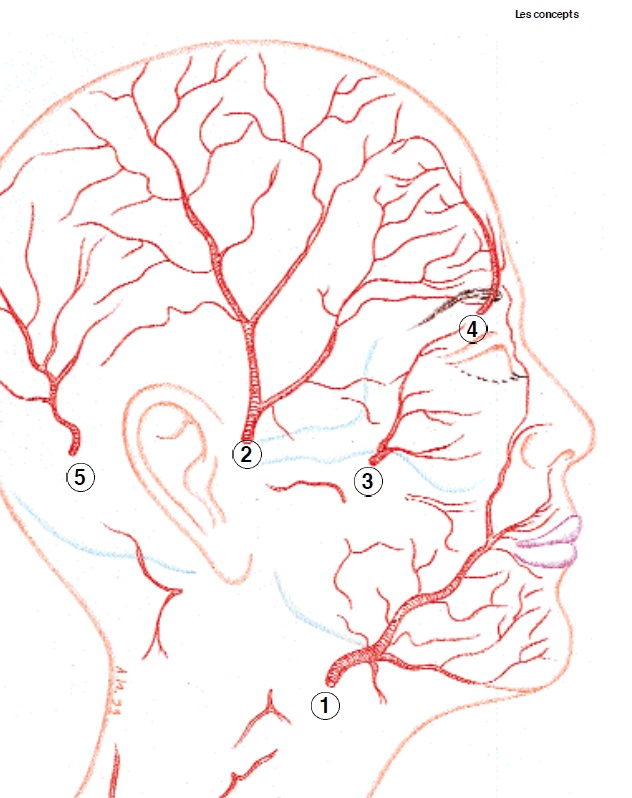Anatomy
Videos
ADV Library
In this section, you can find essays and PowerPoints sent by our contributors. They are academic papers drafted by Diplômes Universitaires students partnered by ADV.
They made our history…
Esthetic units
Plastic and esthetic face surgery relies on general anatomical knowledge, surgical anatomical concepts, ageing physiological mecanism understanding and face esthetic analysis. This knowledge makes a clear distinction between anatomical areas and esthetic units which are not directly stackable. Separation of face and neck in three thirds, superior or cranial, medium or facial, inferior or cervial is the most basic separation but it relies on skeletal considerations which are quite inappropriate to plastic and esthetic surgery.
Consult for SFORL report on esthetic units analysis
Fronto-orbital area
Fronto-orbital area covers the superior third of the face and has a crucial importance in facial esthetic surgery with the singularity of implying eyes and perioral and frontal muscles. They have an essential rôle in the mimicry and are directly interested in the ageing process as far a determining the specific terms of ageing in this area. The perioral muscles game and balance enable the mimicry different expressions : astonished, anxious or worried look. The eyelids tone, skin quality, existence or absence of palpebral fat pockets and the position of the eyebrow condition the radiant, sad and tired or on the contrary fresh and rested face.

Consult the SFORL report on fronto-orbital area
Labial and cervical area
Cervico-facial area is composed of a facial infra-zygo portion represented by the cheek and a cervical portion. Ageing effects are dominated here by the jugal ptosis, the digging of naso-labial fold, the rupture of face oval, the filling of cervico-chinese angle and the cutaneous and muscular loosening of the neck. Techniques which correct these ageing effects are all gathered under the term of cervico-facial lifting.

Consult the SFORL report on labial and cervical area
Vascularisation
Anatomical study of face vascularisation benefits from modern techniques and radio-anatomy progress :
– intravascular injection of a radiopaque product or selfcuring resin ;
– selective injection of pigments in the corpse or living body (before the setting of an arterial catheter for instance) ;
– radio-anatomical study of a living body
Consult the SFORL report on face vascularisation
Innervation
The aim of this chapter is to precise the surgical anatomy of nerves innerving face and neck superficial structures and to know marks of different nerve branches so as to avoid them along plastic and esthetic surgical operations.
The preservation of facial nerve branches remains one of the main préoccupations of the cervico-facial surgeon. The temporo-frontal branch is the facial nerve branch the most frequently injured in facial plastic surgery and especially during temporal and frontal liftings ; its injury can also occur during the accessibility of the zygo by coronal way. The labial-chinese branch is particularly exposed to the réalisation of deep liftings and limits the detachment under the SMAS (Fig1). Sensitive nerves are the easiest to preserve and sensitive deficits are better experienced by the patients, as they are most of the time transitory. Mastering the nervous risks is a mandatory prerequisite for risky surgical techniques réalisation. Every facial esthetic surgery which would lead to a definitive motor facial deficit would have lost its significance and value. We can describe the extra-cranial facial nerve and the muscles innervation of the mimicry. Then we will get interested in the face sensitive innervation.
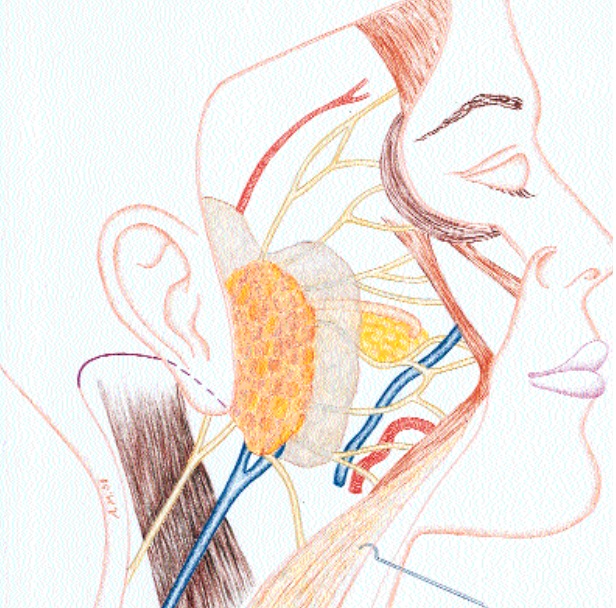
Dissection plans
Face and neck plastic and esthetic surgery have 4 principles and objectives :
– minimising iatrogeny
– concealing cutaneous scars
– mobilising face superficial structures to reposition them
– exposing anatomic structures that we need to work on (bones, muscles, fatty tissues).
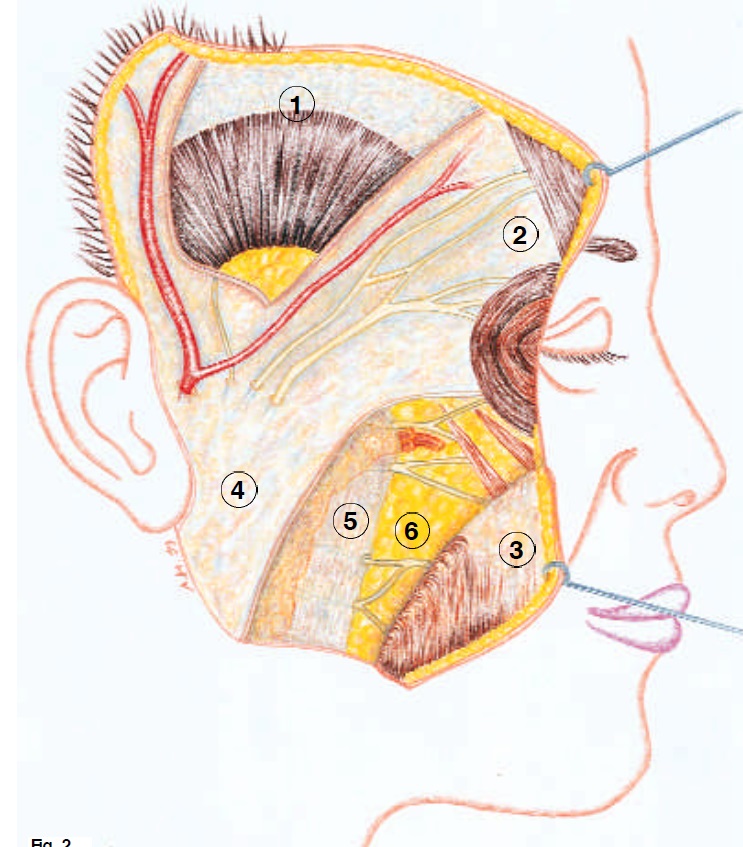
Consult the SFORL report on dissection plans
Facial analysis
Facial analysis is an exam technique to be set before any patient asking for corrective surgery. The surgeon must first make things clear with a deepened questioning about the exact nature of the request or of the raised problem. You should in no way be satisfied with words like « my face got old » or « my nose is too long » and directly proposing a lifting or a rhinoplasty. It is the same thing for maxillofacial dysmorphoses surgery. The questioning must help patients expose his/her trouble and enjoy his/her motivations. Fears regarding the operating act and hopes for results will be discussed. It is important to analyse the facial traits in a reproductible position to obtain the same data after each exam. Thus, the mouth opening alters the face vertical dimension and modifies lip report. In the same way, if the patient raises or lowers his/her gaze, he/she fades or projects his/her chin, transforming the cervico-chinese line. This is visible from the front but significantly more noticeable in profile. The patient’s gaze must be found horizontally and this fixes his/her head in a natural position.

Consult the SFORL report on facial analysis
Surgical analysis by anatomical areas
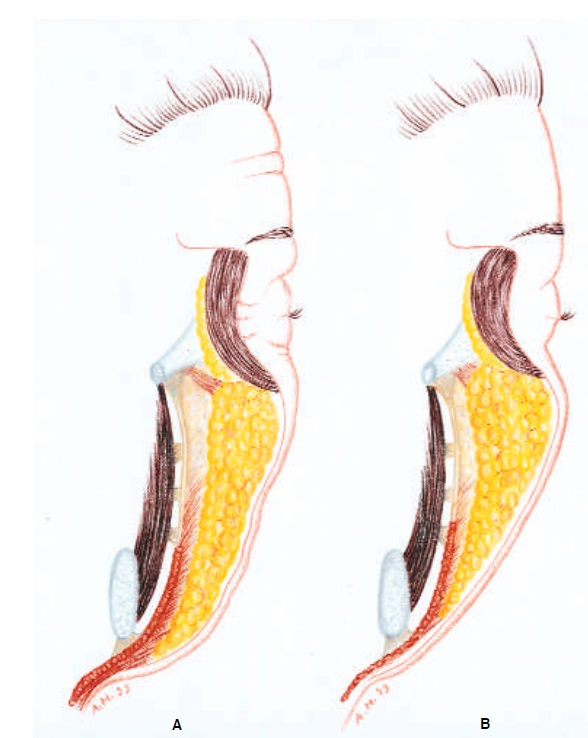
Facial analysis is separated in many subunits. You will find here the SFORL reports about analysis :
Blepharoplasties
Eyelids surgery represents the first request in facial esthetic surgery. Its setting is made either in the cases of isolated gestures, or in the cases of larger rejuvenation programs associating corrections of the three face steps. FRom a surgical point of view, the singularity of blepharoplasties lies in the multiplicity of described techniques to face different forms of anatomic alterations provoked by the ageing of eyelids, these complex organs.
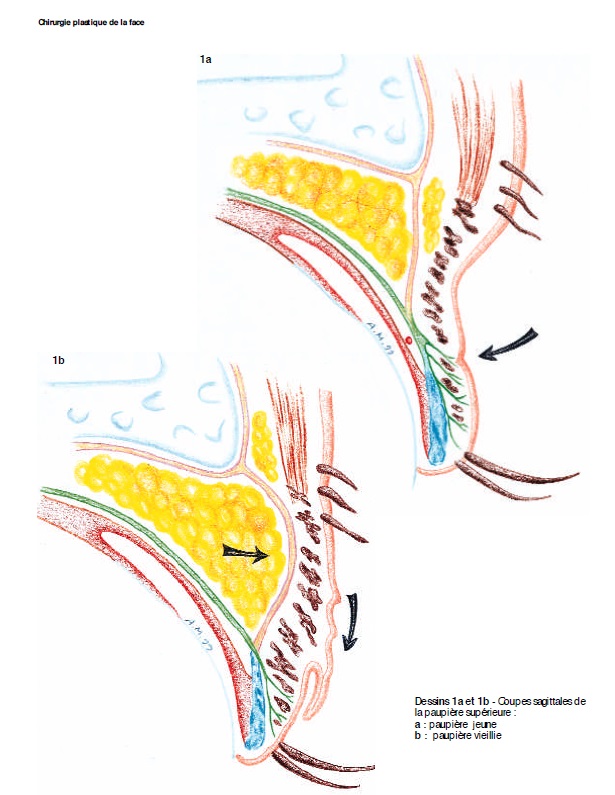
Consult the SFORL report about blepharopalsties
Cervical facial liftings
The request for facial esthetic surgery has continued to increase these last years ; even if the psychological benefit from this type of surgery is now largely known, motivations that lead a patient to consider a surgery of this type remain extremely varying and always very personal. The first role of a surgeon is to understand the patient’s request and make a relation between what is wished and what is medically and technically possible.

Consult the SFORL report on cervical facial liftings
Rhinoplasty
This theme is detailed in the rhinoplasty section
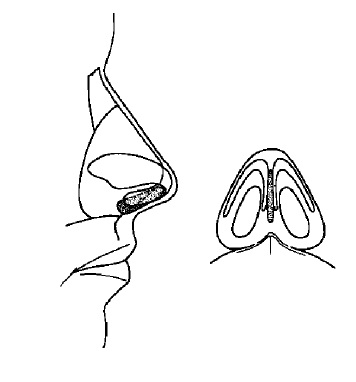
Scheme drawn from SFORL report about rejuvenation rhinoplasty.



